Have you noticed that this year, the trees appear to be particularly generous in their abundance of fruits and seeds? There is speculation 2025 could be classed as a ‘mast year’ for some species, such as oaks. Indeed, the Sheriff of Nottingham has proclaimed it so for Sherwood Forest. A mast year is when trees produce a significantly larger crop of fruit and seeds, compared to normal years. This crop is known as ‘mast’ and it’s a clever survival strategy. Irregular crop volumes keep predator numbers low, so when a mast year happens, there aren’t going to be enough predators to eat all the seeds, ensuring some survive to become the next generation.
Autumnal Abundance Filling our Hearts and Larders
Abundant berries and fruits at Ramsey Heights
In the Great Fen, our education centre is at the Ramsey Heights nature reserve. Here we have certainly noticed brambles, blackthorn, hawthorn, oak and apple trees having a very productive year. Recipes such as apple and blackberry crumble, hawthorn ketchup and hedgerow jelly leap to mind. Aside from filling our bellies, these fruits are rich in antioxidants and vitamins to support our immune systems in the colder months. Why not try turning rosehips into syrup for a vitamin C boost to your breakfast, or haws into fruit leather for snacks? Preserving these fruits as jams, chutneys, syrups and more provides access to their fantastic flavours all year round.
If you are foraging, be sure to do so responsibly. That means, leaving plenty for wildlife! They rely solely on nature’s bounty. Only pick what is in abundance, and what you are confident in identifying. As one of our favourite social accounts, @BlackForager, points out in her regular game of ‘One is Poison, One is a Snack’, many plants and berries look similar but can have vastly different results! If you’re not 100% sure what that plant is, leave it alone. Remember that some fruits and seeds can only be consumed after some form of processing, such as cooking elderberries and rowan berries, or soaking acorns to remove tannins. Do your research!
Whether you plan to consume the fruits hanging heavy from the boughs or not, their sight is certainly something to celebrate. The myriad colours of dark red hawthorn berries, bright red rosehips, deep purple plums and dusky blue sloes lift our spirits as we walk beneath. The fruits attract masses of wildlife who will feast in preparation for winter or long migrations and watching them is just as enjoyable for us. Windfall plums and apples are enjoyed by butterflies, deer, badgers and wasps. Check broken hazelnut shells for tiny teeth marks to see if you can identify if voles, mice or squirrels have been harvesting. If you pass a tree ripe with clusters of shiny, black elderberries, pause and watch who is visiting. Robins, blackbirds, thrushes and blackcaps will feed greedily on the berries. Other birds will pick off the insects attracted to the juices. Get up close and look at the tiny creatures flying, scuttling and creeping amongst the changing leaves. Notice patterns on wing cases, tiny hairs covering bodies, veins threading through wings and how the light reflects from their fascinating compound eyes.
There’s nothing quite like a delicious meal of free foraged food. And there’s nothing quite like a mindful stroll through a colourful, autumnal woodland admiring the beauty of nature. Which of our reserves will you visit in October? www.wildlifebcn.org/nature-reserves

Autumn colours of birch and bracken at Holme Fen - Sarah Lambert








